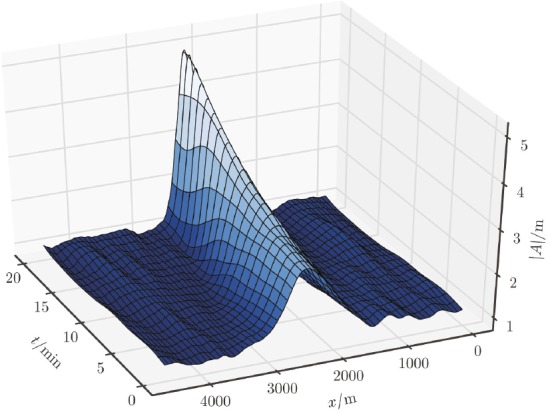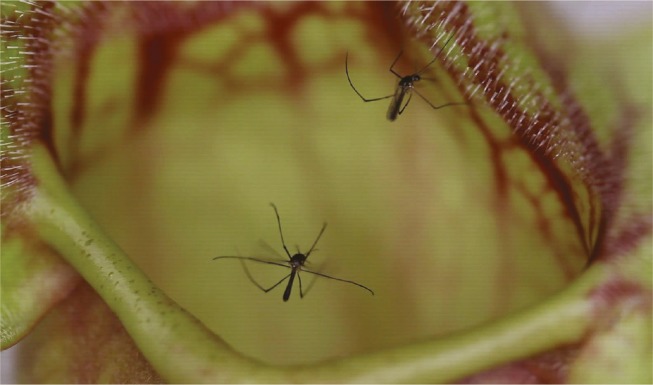Transition from blood feeding to nonbiting mosquitoes
Pitcher plant mosquitoes hovering above a water-filled leaf.
When mosquitoes feed on blood, they can spread pathogens, such as those responsible for malaria, West Nile virus, and Zika, but certain nonbiting species never take a blood meal. Identifying genes associated with blood feeding could yield strategies to help counter mosquito-borne diseases, but biting and nonbiting lifestyles are typically found in separate, genetically incompatible species. William Bradshaw et al. (pp. 1009–1014) used Wyeomyia smithii—a mosquito species with a regional population of blood feeders and obligate nonbiters distributed throughout the rest of its range—to generate a line of avid biters via direct selection for blood feeding. The authors compared this line with their nonbiting cohorts to identify genes related to the transition from blood feeder to obligate nonbiter. By comparing differential gene expression between avid biters and nonbiters, the authors found that the transition from blood feeding to an obligate nonbiting lifestyle occurs via natural selection and reflects a shift from the high metabolic cost of preparing for a blood meal to a low-cost, opportunistic lifestyle. Although specific target genes remain to be pinpointed, current approaches could help target the biting phenotype itself as a means to control vector-borne disease, according to the authors. — T.J.
Predicting rogue waves in deep seas

Pathway of maximum likelihood rogue wave evolution.
Towering above the surface of the ocean by as many as 20–30 meters, rogue waves represent a threat to boats and nautical structures. Long dismissed as seafaring lore, these marine leviathans arise seemingly without warning and through poorly characterized mechanisms. Giovanni Dematteis et al. (pp. 855–860)describe a method that identifies ocean states that act as precursors to rogue waves and that can potentially be exploited for an early warning system. Using the modified nonlinear Schrödinger equation in one spatial dimension, initialized with random data consistent with observations, the authors demonstrate that an optimization problem can be efficiently solved to predict the pathway and likelihood of rogue waves. Furthermore, the analysis reveals that rogue waves arise from pockets of unlikely wave configurations with a specific shape. The method, which yields probabilities of observing high-amplitude waves within a time window, can be generalized for other deterministic, dynamical systems, given prior statistical information about the systems, according to the authors. — T.J.
Naturalization barriers for low-income immigrants

A new US citizen reads the Oath of Allegiance. Image courtesy of Alexander W. Riedel (US Air Force).
In surveys, most US immigrants say they hope to become citizens, yet the United States has lower naturalization rates than Australia, Canada, and the United Kingdom. Jens Hainmuller et al. (pp. 939–944) examined the effect of certain policy interventions on naturalization application rates among low-income lawful permanent residents (LPRs) in New York State. The study included participants, ages 18 years and older, who were registered with a public/private naturalization program between July and September 2016. Among them, 863 participants with household incomes between 150% and 300% of the Federal Poverty Guidelines were entered into a lottery to receive a voucher to pay for the naturalization application fee. Participants who received a voucher were twice as likely to apply for naturalization as those who did not receive a voucher. Another 1,760 participants who had incomes below 150% of the Federal Poverty Guidelines, and therefore qualified for an application fee waiver, were randomly assigned to receive various low-cost behavioral inducements designed to encourage participants to apply for naturalization and seek free application assistance. Application rates among those receiving any of the inducements did not differ significantly from those who did not receive inducements. The results suggest that the application fee is a significant obstacle to naturalization for many low-income LPRs, but that the poorest immigrants face additional challenges that low-cost interventions cannot easily overcome, according to the authors. — B.D.
Sneezing and spread of influenza virus
The airborne transmission of influenza viruses is commonly thought to occur through coughing and sneezing. However, the importance of airborne transmission has been unclear due to the lack of human data on the amount and infectiousness of influenza virus shed into exhaled breath. Jing Yan et al. (pp. 1081–1086) characterized influenza virus in exhaled breath from 142 confirmed cases of community-acquired influenza. The participants provided 30-minute samples of exhaled breath, spontaneous coughing, and sneezing on the first, second, and third days after symptom onset. The authors recovered infectious virus in 39% of fine aerosol samples, demonstrating that a significant fraction of influenza cases routinely shed infectious virus into aerosol particles small enough to remain suspended in air and to present a risk for airborne transmission. Surprisingly, 48% of the fine aerosol samples acquired in the absence of coughing had detectable viral RNA. Moreover, the few sneezes observed were not associated with greater viral RNA copy numbers in exhaled aerosols. Taken together, the results suggest that sneezing and coughing are not necessary for the generation of infectious aerosols. According to the authors, the findings could be used to improve mathematical models of the risk of airborne influenza transmission and to improve public health interventions. — J.W.
Rising obesity and mortality rates in the United States
Recent studies have documented a reduction in the rate of mortality improvement in the United States, as well as an increasing mortality disadvantage in the United States relative to other wealthy countries. Samuel Preston et al. (pp. 957–961) assessed the extent to which this trend could be explained by rising body mass index. The authors applied a statistical model to nationally representative data obtained from the National Health and Nutrition Examination Survey from 1988 to 2010, as well as linked mortality files that included follow-up into death records through 2011. The final sample consisted of 25,269 adults aged 40–84. Over this time period, the rise in maximum lifetime body mass index in this population was associated with reduced annual rate of improvement in death rates by 0.54%. Moreover, the increase in maximum lifetime body mass index over this time period was tied to reduced life expectancy at age 40 by 0.9 years in 2011 and to 186,000 excess deaths in adults aged 40–84 that year alone. According to the authors, rising obesity may have prevented individuals in the United States from enjoying the full benefits of reductions in smoking, medical advances, and other factors that have reduced mortality rates in recent decades. — J.W.
Armed conflict and HIV spread in Ukraine
Ongoing political unrest in eastern Ukraine has led to the relocation of more than 1.7 million people in a country plagued by one of the largest HIV epidemics in Europe. To determine whether the large-scale movement of people displaced by war reflects HIV spread within the country, Tetyana Vasylyeva et al. (pp. 1051–1056) analyzed HIV-1 subtype A polymerase DNA sequences collected from 427 patients at 24 regional clinics between 2012 and 2015—a period spanning the onset of the current military conflict in 2014. Epidemiological and phylogeographic analysis revealed that the eastern regions of Donetsk and Lugansk—home to nearly a quarter of the country’s registered HIV-infected people—were the main exporters of viral lineages within the country. From the East, the virus appears to have spread to the central and southern regions, as well as to the cities of Kyiv and Odessa. Following 2013, the start of the armed conflict represents a watershed for virus dissemination, with the movement of war-displaced people mirroring the redistribution of extant viral infections within the country. Virus importation events were partly correlated with sexual practices among people who inject drugs—a group considered a major driver of the epidemic; consistent use of condoms during sex was tied to lower importation. Conversely, the number of virus exportation events to a given location rose with the number of internally displaced people who moved to that location. According to the authors, the study underscores the need for HIV surveillance and prevention measures in regions of Ukraine beyond those directly affected by armed conflict. — P.N.



